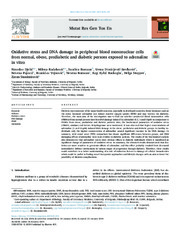Приказ основних података о документу
Oxidative stress and DNA damage in peripheral blood mononuclear cells from normal, obese, prediabetic and diabetic persons exposed to adrenaline in vitro
| dc.creator | Đelić, Ninoslav | |
| dc.creator | Radaković, Milena | |
| dc.creator | Borozan, Sunčica | |
| dc.creator | Dimirijević-Srecković, Vesna | |
| dc.creator | Pajović, Nevena | |
| dc.creator | Vejnović, Branislav | |
| dc.creator | Borozan, Nevena | |
| dc.creator | Bankoglu, Ezgi Eylul | |
| dc.creator | Stopper, Helga | |
| dc.creator | Stanimirović, Zoran | |
| dc.date.accessioned | 2020-06-03T14:36:25Z | |
| dc.date.available | 2020-06-03T14:36:25Z | |
| dc.date.issued | 2019 | |
| dc.identifier.issn | 1383-5718 | |
| dc.identifier.uri | https://vet-erinar.vet.bg.ac.rs/handle/123456789/1780 | |
| dc.description.abstract | Diabetes represents one of the major health concerns, especially In developed countries. Some hormones such as the stress hormone adrenaline can induce reactive oxygen species (ROS) and may worsen the diabetes. Therefore, the main aim of the investigation was to find out whether peripheral blood mononuclear cells (PBMCs) from normal persons have less DNA damage induced by adrenaline (0.1, 1 and 10 mu M) in comparison to PBMCs from obese, prediabetic and diabetic patients. Also, the biochemical parameters of oxidative stress (TBARS, catalase) and lactate dehydrogenase were monitored. It was observed that higher concentrations of adrenaline (1 and 10 mu M) induced DNA damage in the obese, prediabetic and diabetic groups. In healthy individuals only the highest concentration of adrenaline caused significant Increase in the DNA damage. In summary, total comet score (TCS) comparison has shown significant differences between groups, and DNA damaging effects of adrenaline were most evident in diabetic patients. The results of the biochemical analysis also demonstrate that adrenaline exerts most obvious effects in diabetic individuals which is manifested as significant change of parameters of oxidative stress. In summary, the obtained results demonstrated that diabetics are more sensitive to genotoxic effects of adrenaline and this effect probably resulted from decreased antioxidative defence mechanisms in various stages of progression through diabetes. Therefore, these results could contribute to a better understanding of a role of endocrine factors to damage of cellular biomolecules which could be useful in finding novel therapeutic approaches and lifestyle changes with an aim to lower the possibility of diabetes complications. | en |
| dc.publisher | Elsevier, Amsterdam | |
| dc.relation | DAADDeutscher Akademischer Austausch Dienst (DAAD) | |
| dc.relation | info:eu-repo/grantAgreement/MESTD/Integrated and Interdisciplinary Research (IIR or III)/46002/RS// | |
| dc.relation | COST action hCOMETEuropean Cooperation in Science and Technology (COST) [CA 15132] | |
| dc.rights | openAccess | |
| dc.source | Mutation Research-Genetic Toxicology and Environmental Mutagenesis | |
| dc.subject | Diabetes | en |
| dc.subject | Oxidative stress | en |
| dc.subject | DNA damage | en |
| dc.subject | PBMC | en |
| dc.subject | Adrenaline | en |
| dc.title | Oxidative stress and DNA damage in peripheral blood mononuclear cells from normal, obese, prediabetic and diabetic persons exposed to adrenaline in vitro | en |
| dc.type | article | |
| dc.rights.license | ARR | |
| dcterms.abstract | Ђелић, Нинослав; Станимировић, Зоран; Борозан, Сунчица; Вејновић, Бранислав; Стоппер, Хелга; Банкоглу, Езги Еyлул; Борозан, Невена; Пајовић, Невена; Димиријевић-Срецковић, Весна; Радаковић, Милена; | |
| dc.citation.volume | 843 | |
| dc.citation.spage | 81 | |
| dc.citation.epage | 89 | |
| dc.citation.other | 843: 81-89 | |
| dc.citation.rank | M22 | |
| dc.identifier.wos | 000483453100013 | |
| dc.identifier.doi | 10.1016/j.mrgentox.2019.01.013 | |
| dc.identifier.pmid | 31421743 | |
| dc.identifier.scopus | 2-s2.0-85061112539 | |
| dc.identifier.fulltext | https://vet-erinar.vet.bg.ac.rs/bitstream/id/742/1779.pdf | |
| dc.type.version | publishedVersion |

